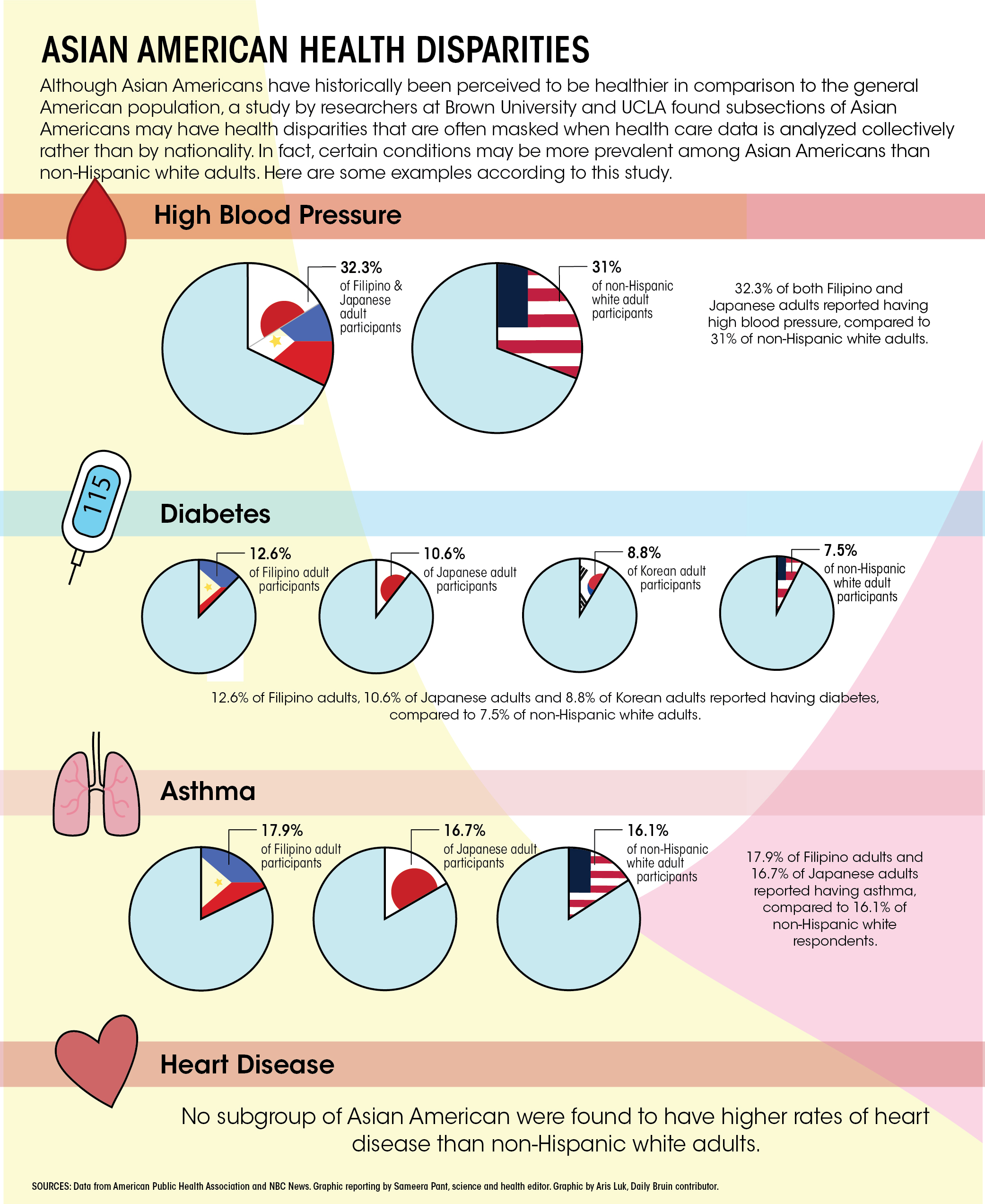Study shows aggregated data conceals Asian American subgroup health problems

By Keaton Larson
March 6, 2020 1:17 a.m.
Asian Americans may have health conditions that are hidden by the way data is collected, researchers at UCLA and Brown University found.
Researchers from both universities analyzed data of the Filipino, Vietnamese, Chinese, Japanese and Korean subgroups of the Asian American population. The resulting study, published in the American Journal of Public Health on Feb. 20, found that Asian American subgroups may have disproportionately more health problems and less access to care when compared to non-Hispanic white adults.
These conditions otherwise would be masked when health data is aggregated, according to the study.
Historically, Asian Americans have been branded as a “model minority” because of the cultural expectation that a certain minority group will have favorable qualities compared to other subpopulations. This is in spite of evidence that Asians experience healthcare disparities, the study read.
Data disaggregation – breaking down compiled data into subpopulations – has been considered as a method to break down the perception of Asian Americans as a “healthier” model minority, according to the study.
“Aggregation shouldn’t be the standard,” said Alex Adia, the first author of the study and a researcher from Brown University. “It shouldn’t be viewed as the default choice.”
Adia added that the choice to disaggregate should be seen as a choice to properly categorize the sort of outcomes, health conditions and service access people face.
The lack of disaggregated health data disguises the need for intervention and further research into serious health conditions. Such health effects may impact subgroups individually but are not noticeable when this health data is aggregated into a single racial category, the study read.
The researchers analyzed data from the California Health Interview Survey for their report. CHIS is a phone- and web-based survey conducted to examine the health statuses of subpopulations across the state. The survey is carried out by the UCLA Center for Health Policy Research alongside the California Department of Public Health and the Department of Health Care Services.
Researchers used CHIS data from 2011 to 2017 to identify health disparities in three categories: health condition, health outcomes and health service access.
Filipino, Vietnamese, Chinese, Japanese and Korean groups had the most responses to CHIS, which allowed the team to create subgroups for each of these. Other Asian groups were included in CHIS in the general Asian category, but there was not a large enough collection of responses to categorize them into a single subgroup, the study stated.
According to the study, Filipino adults appear to be in the worst health on average compared to the other Asian subgroups.
The most notable disparities among Filipinos when compared to other subgroups are higher rates of obesity or excessive weight, high blood pressure, diabetes and asthma. Among Asian subgroups, they have the highest rates of heart disease, although they did rank lower than non-Hispanic white adults in this category, who have the highest prevalence of this condition.
Despite these differences, Filipino adults reported higher rates of bachelor’s degrees, insurance coverage and English fluency compared to most other responses in CHIS.
“The big surprise was that Filipinos, who have socioeconomic advantages in terms of doing well, particularly as immigrants, had the most disparities after disaggregation,” said Ninez Ponce, a co-author of the study and a professor at the UCLA Fielding School of Public Health.
Furthermore, Filipinos are overly represented in health care services but face specific factors that influence their disparities, Adia said.
“Filipino Americans are disproportionately involved in the provision of health care, but it seems the data practices that we currently employed aren’t great at identifying their needs,” Adia said.
While Filipino adults on average are the least-healthy subpopulation, Chinese Californians appear to be the healthiest subgroup with the fewest negative disparities compared with non-Hispanic white adults.
However, Ponce said this does not mean that Chinese adults are necessarily healthier, due in part to the fact that the health outcomes are self-reported.
More study is required to identify how Chinese adults might be more healthy compared to other Asian subpopulations, said Adia, who is currently working on follow-up research.
Each subgroup ranked higher in at least one health disparity compared to other subpopulations, according to the study.
For example, Vietnamese adults had the highest rates of fair or poor health and disability while Korean adults suffered from the highest rates of serious distress. Additionally, Korean adults ranked highest in no usual source of care and delayed care in terms of health service access.
Conversely, Chinese adults ranked highest in the category of no doctors visits in the past year, and the Japanese subgroup topped high blood pressure at the same rate as Filipino adults.
Ponce, who is the principal investigator of CHIS, said she was excited to see this data being used in the United States and around the globe to properly identify the disparities of Asian subgroups.
Ponce added she plans to continue researching these disparities and hopes proper disaggregation can continue for the benefit of subgroups.

